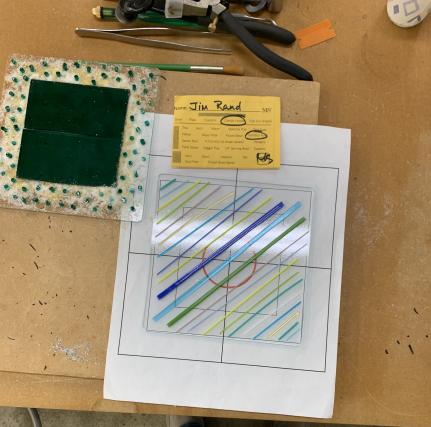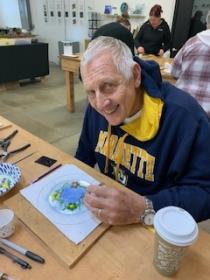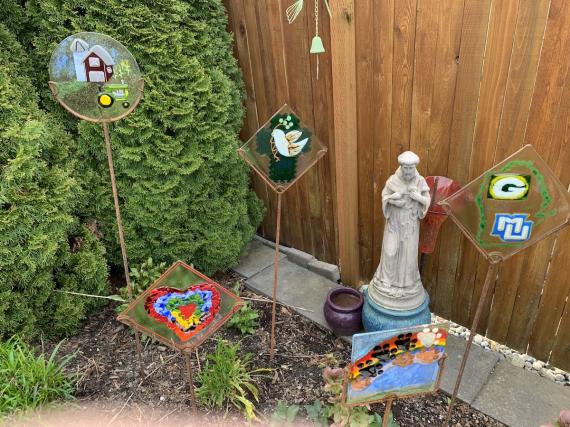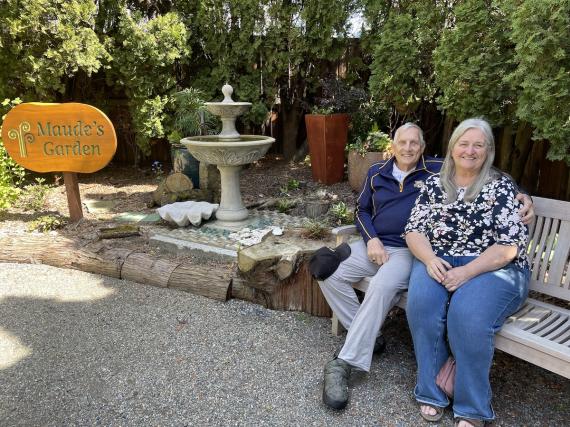“There’s this joy of standing back and seeing the creation.” - Jim Rand
When Jim Rand sits outside in his yard, he looks out onto a garden of handmade glass artworks, each depicting a memory from his life: the family farm in Wisconsin he visited as a child, his time in the military, his seven climbs up Mount Rainier, their family dogs, and the Green Bay Packers. One glass piece honors his father with a cross, dove, and olive branch. Another honors his mother with a rainbow heart.
“Because Jim knows these things,” says Jama Rand, his wife of 43 years, “the glass art can help support his memories and emotions around these events.” Five years ago, Jim received a diagnosis of dementia due to Alzheimer’s disease and now receives care at the UW Memory and Brain Wellness Center and participates in programs at the Memory Hub. This backyard garden, filled with stones and glass art, keeps his memories, literally, within reach.
“Jim likes to spend time in the yard. We got this idea to make glass art that he can enjoy out in the sun,” says Jama, who teaches online university courses and has always had a creative outlet, including knitting, watercolor, and stained glass making.
As Jim’s symptoms of dementia progressed, Jama realized that she couldn’t leave him at home while she attended glass art classes at Molten Glass Works, a local studio. So, she involved him. “Last fall, we began to work on some projects meaningful to Jim,” she says. “We sort of fell into it. We started with what Jim remembers –things that will trigger memories. First, we made a rainbow.”
The process they use at the studio to create the glass memories is called glass fusing. This approach is more accessible than other glass art methods, such as glass blowing or stained glass. In glass fusing, the artist arranges small pieces, shards, and rods of glass on a surface. When fired in a kiln at 1490 degrees Fahrenheit, the glass merges into unique and colorful designs. Fused glass is commonly used to create plates, bowls, wall hangings, or other creations such the decorative tiles that Jim and Jama made as garden art.
At the time of his diagnosis, Jim Rand had never created art of any kind. For 25 years, Jim taught university courses in operations management, compensation management, and human relations. He is an Army veteran and holds a law degree and a doctorate in labor law and economics. But on the journey through memory loss, he found a new way to express himself and feel successful.

Jim's work before it enters the kiln. Courtesy Jim and Jama Rand
“Anytime you get involved in art, it’s a beautiful thing, right?” says Jim. “It was good to start from pieces of glass—then put it together into something useful and beautiful. There’s this joy of standing back and seeing the creation.”
Jim says that glass fusing reminds him of the process of negotiation, in the legal context. He takes pieces of glass—just like pieces of information in a legal case—and puts them together into something that makes sense. “Glass art was natural for me,” he says.
Jama gives credit to the glass studio for understanding Jim’s condition. “The studio staff loves having Jim there, which is great,” says Jama. “The environment is safe, and the people are welcoming.” Jim participates in the activity by placing glass pieces and rods on the plates that will be fired in the kiln. “Jim has an artistic eye. We talk about colors and placement.” Recently, they have been creating striped vases from the fused glass.
Jim and Jama enjoy being part of the Memory Hub community, especially exploring and relaxing in Maude’s Garden. Looking around, Jama can see spots where glass art would add interest and permanent color. She has an idea for a community art project, inspired by glass art. “You could make small mosaics on stepping stones for the garden,” Jama says.
Both Jim and Jama hope their story shows how much communities beyond Seattle could benefit from more dementia-friendly creative opportunities. “We need to expand this whole idea of art for people living with dementia,” says Jama. Jim explains, “It’s the importance of linking what you have done in your life to the art you create.” • Genevieve Wanucha









